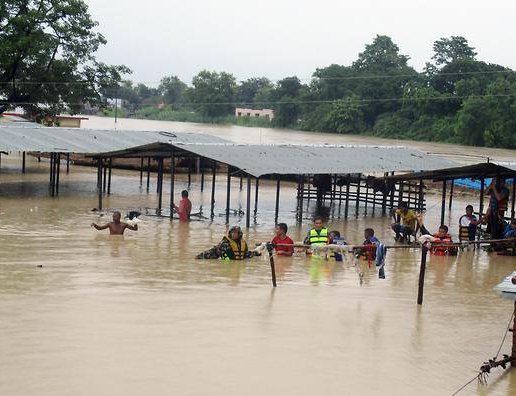
UN Resident and Humanitarian Coordinator said that Nepal needs over 41.4 million dollars for the recovery and reconstruction efforts following the floods.
An ‘Initial Rapid Assessment’ (IRA) conducted in 28 districts assessed that 1.7 million people have been affected by the flooding. According to a report published by UN Resident and Humanitarian Coordinator for Nepal Published on 25 Aug 2017, there need $1.78 Million in health, $ 3 million in education,$ 3.4 million in early recovery, $4.12 million in shelter.$ 4.5 million in agriculture, $6.85 million in food aid, $8 million in nutrition,$ 1 million in coordination and $ 8 million in wash sector.
According to a report published on August 25, beginning in the second week of August 2017, Nepal experienced a period of sustained, heavy rainfall resulting in widespread flooding across 35 of the country’s 75 districts. Several districts recorded the heaviest rainfall in 60 years, and over 80 percent of land in the southern Terai region was inundated by flood waters.
An ‘Initial Rapid Assessment’ (IRA) conducted in 28 districts assessed that 1.7 million people have been affected by the flooding. With almost 65,000 houses destroyed, 460,000 people have been displaced and there are an estimated 19,000 persons currently residing in informal displacements sites including in schools. Some 40 communities remain inaccessible.
Despite the swift efforts of the Government of Nepal, which mobilized 27,000 security personnel and civil servants to support relief efforts and has provided more than US$11.3 million to affected areas, humanitarian needs are significant. Women and girls, as well as marginalized and vulnerable groups, are particularly impacted and in need of targeted support.
The floods have had a significant impact on critical infrastructure with 80 schools across 28 districts destroyed and a further 710 damaged. Ten health posts have been destroyed and 64 have been partially damaged. In addition, 64,000 hectares of standing crops have been destroyed in the ten worst affected districts. This will likely impact communities’ livelihoods and compromise food security, which is being compounded as food stocks have also been destroyed. People are now dependent on food distributions, but to date these have not been sufficient to meet basic needs.
“Nutrition needs have reportedly increased since the onset of flooding with the average rate of global acute malnutrition (GAM) now beyond “critical” levels; this situation will likely deteriorate further amongst children under five and pregnant and breastfeeding women without emergency measures. The recent flooding has also exacerbated the pre-crisis vulnerabilities of Terai districts. Many of the impacted areas in the Terai were affected by major flooding in 2014 and had yet to fully recover, while many of the flood affected districts, including Saptari, Rautahat, Mahottari, Dhanusa and Siraha, have some of the country’s lowest development indicators,” said report.
- TANAHU HYDROPOWER PROEJCT: A Significant Achievement
- Apr 15, 2024
- AMBASSADOR HANAN GODAR: Sharing Pain With A Nepali Family
- Mar 30, 2024
- VISIT OF KfW AND EIB TO NEPAL : Mission Matters
- Mar 25, 2024
- NEPAL BRITAIN SOCIETY: Pratima Pande's Leadership
- Mar 24, 2024
- NEPAL ARMY DAY: Time To Recall Glory
- Mar 15, 2024
















